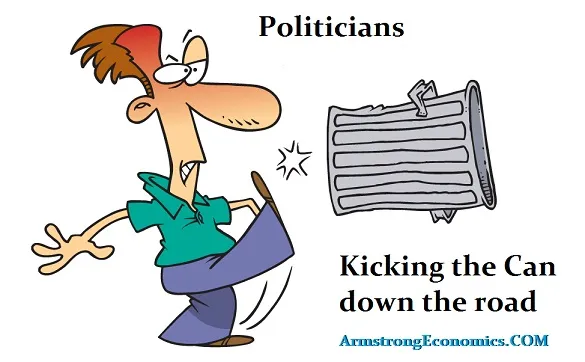Bubble
News

Russia's Total Gold Reserves Top $100 Billion As Central Bank Adds Another 600K Ounces In June
The Russian central bank bought another 597,000 ounces or 18.67 tonnes of gold in June, which put the total gold holdings at 2,208 tonnes as of July 1 ?r $100.3 billion, the Russian central bank said in the latest data release.
It's Not Just the News That's Fake--Everything's Fake
What do we mean when we say corporate media is fake? We mean it's a carefully crafted con, a set of narratives, cherry-picked data and heavily massaged statistics (the unemployment rate, etc.) designed to instill the reader's confidence in a narrative that serves the interests not of the citizenry but of a select few pillaging the citizenry.
An essential component of the American ethos is: don't be a chump. Don't fall for the con. And if you do, it's your own fault. America in 1857 was a simmering stew of con artists, flim-flammers and grifters exploiting the naive, the trusting and the credulous, and that remains the case in 2019.
Melville understood that we want to be conned: we want to believe the elixir will make our aches and pains go away, that the new face in politics will clear out the rot of corruption, that rising prices for everything means we're getting richer and so on.

Prosperity: fake:
Trillions of dollars in new currency and credit have inflated assets to absurd levels, all to create the illusion that everything's getting better in every way, every day.
The $6 Trillion Pension Bailout Is Coming
While pension plans in the United States are guaranteed by a quasi-government agency called the Pension Benefit Guarantee Corporation (PBGC), the reality is the PBGC is already nearly bust from taking over plans following the financial crisis. The PBGC is slated to run out of money in 2025. Moreover, its balance sheet is trivial compared to the multi-trillion dollar pension problem.
The proposal from Congress is simply to use more debt. According to the new legislation, whenever a pension plan runs out of funds, Congress wants the pension plan to borrow money in order to keep making payments to beneficiaries.
Think about that for a moment.
Who would loan money to an insolvent pension fund?
Oh, that would be you, the taxpayer.
In other words, the Government wants you to bail out your own retirement fund.
Genius.
But it’s going to get far worse.
We Are Out Of Time
Currently, 75.4 million Baby Boomers in America—about 26% of the U.S. population—have reached or will reach retirement age between 2011 and 2030. And many of them are public-sector employees. In a 2015 study of public-sector organizations, nearly half of the responding organizations stated that they could lose 20% or more of their employees to retirement within the next five years. Local governments are particularly vulnerable: a full 37% of local-government employees were at least 50 years of age in 2015.
The vast majority of these individuals, when they retire, will depend on their pension (if they are in the 15% of the population that has one, and Social Security for a bulk of their living expenses in retirement.
The problem is that pension funds aren’t going to be able to keep their promises.
Social Security, according to its own annual report, will run out of money in 15 years. Medicare has a massive underfunded problem as well.
But yet, the current Administration believes our outcome will be different.
 More debt, and lack of any budgetary controls, will somehow lead to surging levels of economic growth despite no historical evidence of that being the case.
The reality is that the U.S. is now caught in the same liquidity trap as Japan. With the current economic recovery already pushing the long end of the economic cycle, the risk is rising that the next economic downturn is closer than not. The danger is that the Federal Reserve is now potentially trapped with an inability to use monetary policy tools to offset the next economic decline when it occurs. Combine this with:
More debt, and lack of any budgetary controls, will somehow lead to surging levels of economic growth despite no historical evidence of that being the case.
The reality is that the U.S. is now caught in the same liquidity trap as Japan. With the current economic recovery already pushing the long end of the economic cycle, the risk is rising that the next economic downturn is closer than not. The danger is that the Federal Reserve is now potentially trapped with an inability to use monetary policy tools to offset the next economic decline when it occurs. Combine this with:
- A decline in savings rates to extremely low levels which depletes productive investments
- An aging demographic that is top heavy and drawing on social benefits at an advancing rate.
- A heavily indebted economy with debt/GDP ratios above 100%.
- A decline in exports due to a weak global economic environment.
- Slowing domestic economic growth rates.
- An underemployed younger demographic.
- An inelastic supply-demand curve
- Weak industrial production
- Dependence on productivity increases to offset reduced employment
The combined issues of debt, deflation, and demographics will continue to push the U.S. closer to the “point of no return.”
As the aging population grows becoming a net drag on “savings,” the dependency on the “social welfare net” will continue to expand. The “pension problem” is only the tip of the iceberg.
It’s an unsolvable problem.
It will happen.
It will devastate many Americans.
It is just a function of time.
DYI

No comments:
Post a Comment